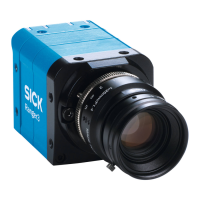Camera IP settings
The GigE Vision® standard dictates that the factory default setting for devices is IP
configuration using DHCP. If no DHCP server is found, the default for devices is to
assign a Link-Local Address (LLA), also called a Zero Configuration IP, on the format
169.254.x.y.
It is recommended to define a persistent IP address which can be used when a device
boots. Which IP configuration option that is used when a device boots is dictated by the
TransportLayerControl parameters, see "Editing IP settings", page 57.
Ranger3 also supports setting a static IP using the GigE Vision® forceIP method. This IP
address is not persistent, which means it is lost at power-off, see "Editing IP settings",
page 57.
Symptoms of possible problem
Receive buffers Symptoms of too low setting: Multiple consecutive packets are lost,
e.g. 31 consecutive packets are lost.
Symptoms of too high setting: Use of memory increases.
Jumbo frames Symptoms of too low setting: The camera will use a smaller frame
size, which implies higher CPU load on the PC.
Symptoms of too high setting: If you use a switch that is unable to
support Jumbo Frames connected between the camera and the PC, it
is impossible to receive streaming data from the camera.
IP settings If the device and the NIC are not connected to the same DHCP server,
or only one end is connected to a DHCP server, the device can not
assign a correct IP.
16.3.1 Connecting multiple cameras
When you connect multiple cameras to the PC, you get the best performance if each
camera is connected to a separate NIC. The camera and the NIC must be on the same
subnet. You can also connect multiple cameras to the same NIC, using a switch. In that
case, both the NIC and all the cameras that are connected to it must be on the same
subnet.
If the PC has multiple NICs, all the NICs must be on different subnets. The subnet is
indicated by the third section of the IP address, see an example in the figure below. This
figure also shows that other equipment, such as network printers, should be connected
to a separate NIC.
ANNEX 16
8020774/1D7Q/2022-03 | SICK O P E R A T I N G I N S T R U C T I O N S | Ranger3
111
Subject to change without notice

